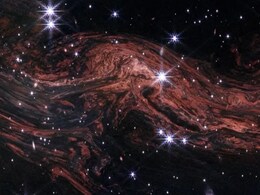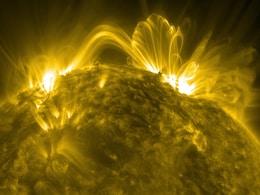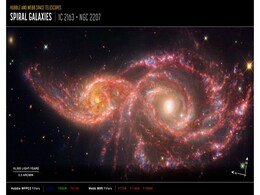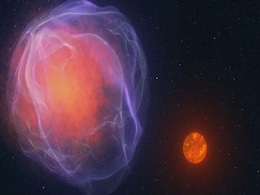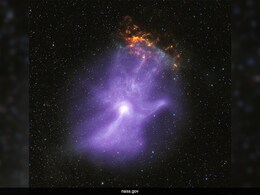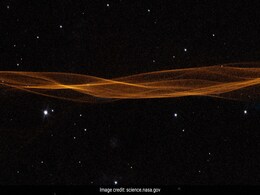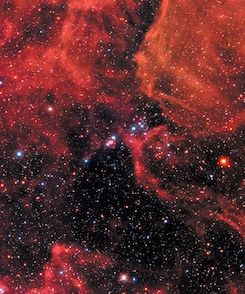Nasa Supernova
- All
- News
- Web Stories
-

Supernova Remnants Found in Oceanic Samples, Scientists Look to Moon
- Wednesday March 26, 2025
- Written by Gadgets 360 Staff
Scientists have identified supernova debris in deep-sea sediments, including a rare plutonium isotope linked to a kilonova. Researchers believe a neutron star collision occurred nearly 10 million years ago, scattering radioactive material across space. To validate this theory, they plan to analyze lunar soil, which remains undisturbed by Earth's ge...
-
 www.gadgets360.com
www.gadgets360.com
-

Hubble Spots Distant Supernova in Gemini, Enhancing Cosmic Distance Studies
- Tuesday February 4, 2025
- Written by Gadgets 360 Staff
The NASA/ESA Hubble Space Telescope has captured a stunning image of SN 2022aajn, a Type Ia supernova in the constellation Gemini. Located 600 million light-years away, the explosion was first detected in November 2022. Type Ia supernovae serve as essential cosmic distance markers due to their predictable brightness. Hubble’s observations, part o...
-
 www.gadgets360.com
www.gadgets360.com
-

James Webb Space Telescope Unveils Hidden Interstellar Wonders of Supernova Cassiopeia A
- Friday January 17, 2025
- Written by Gadgets 360 Staff
The James Webb Space Telescope has provided a rare glimpse into the remnants of a centuries-old supernova in Cassiopeia A. Using infrared technology, the telescope captured a light echo caused by a massive star’s explosion, unveiling new insights into the interstellar medium and its magnetic structures. This breakthrough discovery offers valuable...
-
 www.gadgets360.com
www.gadgets360.com
-

James Webb Space Telescope Detects Supernova From 11.4 Billion Years Ago
- Friday January 17, 2025
- Written by Gadgets 360 Staff
Astronomers using the James Webb Space Telescope (JWST) have identified AT 2023adsv, a supernova that occurred 11.4 billion years ago. This stellar explosion, from a star 20 times the size of the Sun, offers a glimpse into the early universe's unique stellar evolution. Part of the JWST Advanced Deep Extragalactic Survey, the event highlights how th...
-
 www.gadgets360.com
www.gadgets360.com
-

NASA's Webb and Hubble Capture Spooky, ‘Blood-Soaked Eyes’ Galaxies IC 2163 and NGC 2207
- Friday November 1, 2024
- Written by Gadgets 360 Staff
NASA's Hubble and James Webb telescopes have captured the breathtaking merger of galaxies IC 2163 and NGC 2207, located 80 million light-years away. This captivating process, described as a “blood-soaked” cosmic dance, showcases the ongoing star formation occurring between the galaxies as they interact. With an impressive rate of star birth and...
-
 www.gadgets360.com
www.gadgets360.com
-

NASA Citizen Scientists Discover Mysterious Object Moving out of Milky Way at an Extremely High Speed
- Tuesday August 20, 2024
- Gadgets 360 Staff
On August 15, 2024, NASA’s Backyard Worlds: Planet 9 project, featuring the contributions of dedicated citizen scientists, made a groundbreaking discovery: an object moving at an astonishing speed of 1 million miles per hour, which will soon escape the gravitational pull of the Milky Way. This hypervelocity object, catalogued as CWISE J124909.08+...
-
 www.gadgets360.com
www.gadgets360.com
-

NASA to Reportedly Launch an 'Artificial Star' Satellite to Help Astronomers Study the Cosmos
- Tuesday June 18, 2024
- Reported by Gadgets 360 Staff
NASA's groundbreaking Landolt Space Mission will revolutionize astronomy by launching an artificial star into Earth's orbit by 2029. This satellite, about the size of a loaf of bread, will enhance the precision of ground-based telescopes, providing astronomers with more accurate measurements of celestial objects. Equipped with eight lasers, the sat...
-
 www.gadgets360.com
www.gadgets360.com
-

NASA Astronomers Solve Mystery Of "Green Monster", Shares Supernova Remnant Pic
- Wednesday January 10, 2024
- Science | Edited by Anjali Thakur
Green Monster: A new composite image contains X-rays from Chandra (blue), infrared data from Webb (red, green, blue), and optical data from Hubble (red and white).
-
 www.ndtv.com
www.ndtv.com
-

NASA's X-Ray Telescopes Capture Mysterious 'Ghost Hand' In Space
- Wednesday November 1, 2023
- Science | Edited by Nikhil Pandey
NASA's new X-ray telescope observed the haunting 'bones' of a ghostly cosmic hand 16,000 light-years from Earth for a record 17 days.
-
 www.ndtv.com
www.ndtv.com
-

Spectacular NASA Video Displays Fallout Of Star's Supernova
- Sunday October 1, 2023
- Science | Edited by Rahul Kumar
"Hubble is the only way that we can actually watch what's happening at the edge of the bubble with such clarity," said an astronomer.
-
 www.ndtv.com
www.ndtv.com
-

NASA Telescope Captures Never-Before-Seen Details Of Remnant Of Star That Exploded 340 Years Ago
- Saturday April 8, 2023
- Science | Edited by Bhavya Sukheja
NASA's James Webb Space Telescope recently captured "never-before-seen" detail of Cassiopeia A (Cas A), a remnant of a massive star that exploded some 340 years ago.
-
 www.ndtv.com
www.ndtv.com
-

Pics Shared By NASA's Hubble Show Spectacular Aftermath Of Stars' Death
- Tuesday February 28, 2023
- Feature | Edited by Bhavya Sukheja
The aftermath of stars that died in a bright, powerful explosion is seen in images released on Tuesday by NASA's Hubble Space Telescope.
-
 www.ndtv.com
www.ndtv.com
-

Supernova Remnants Found in Oceanic Samples, Scientists Look to Moon
- Wednesday March 26, 2025
- Written by Gadgets 360 Staff
Scientists have identified supernova debris in deep-sea sediments, including a rare plutonium isotope linked to a kilonova. Researchers believe a neutron star collision occurred nearly 10 million years ago, scattering radioactive material across space. To validate this theory, they plan to analyze lunar soil, which remains undisturbed by Earth's ge...
-
 www.gadgets360.com
www.gadgets360.com
-

Hubble Spots Distant Supernova in Gemini, Enhancing Cosmic Distance Studies
- Tuesday February 4, 2025
- Written by Gadgets 360 Staff
The NASA/ESA Hubble Space Telescope has captured a stunning image of SN 2022aajn, a Type Ia supernova in the constellation Gemini. Located 600 million light-years away, the explosion was first detected in November 2022. Type Ia supernovae serve as essential cosmic distance markers due to their predictable brightness. Hubble’s observations, part o...
-
 www.gadgets360.com
www.gadgets360.com
-

James Webb Space Telescope Unveils Hidden Interstellar Wonders of Supernova Cassiopeia A
- Friday January 17, 2025
- Written by Gadgets 360 Staff
The James Webb Space Telescope has provided a rare glimpse into the remnants of a centuries-old supernova in Cassiopeia A. Using infrared technology, the telescope captured a light echo caused by a massive star’s explosion, unveiling new insights into the interstellar medium and its magnetic structures. This breakthrough discovery offers valuable...
-
 www.gadgets360.com
www.gadgets360.com
-

James Webb Space Telescope Detects Supernova From 11.4 Billion Years Ago
- Friday January 17, 2025
- Written by Gadgets 360 Staff
Astronomers using the James Webb Space Telescope (JWST) have identified AT 2023adsv, a supernova that occurred 11.4 billion years ago. This stellar explosion, from a star 20 times the size of the Sun, offers a glimpse into the early universe's unique stellar evolution. Part of the JWST Advanced Deep Extragalactic Survey, the event highlights how th...
-
 www.gadgets360.com
www.gadgets360.com
-

NASA's Webb and Hubble Capture Spooky, ‘Blood-Soaked Eyes’ Galaxies IC 2163 and NGC 2207
- Friday November 1, 2024
- Written by Gadgets 360 Staff
NASA's Hubble and James Webb telescopes have captured the breathtaking merger of galaxies IC 2163 and NGC 2207, located 80 million light-years away. This captivating process, described as a “blood-soaked” cosmic dance, showcases the ongoing star formation occurring between the galaxies as they interact. With an impressive rate of star birth and...
-
 www.gadgets360.com
www.gadgets360.com
-

NASA Citizen Scientists Discover Mysterious Object Moving out of Milky Way at an Extremely High Speed
- Tuesday August 20, 2024
- Gadgets 360 Staff
On August 15, 2024, NASA’s Backyard Worlds: Planet 9 project, featuring the contributions of dedicated citizen scientists, made a groundbreaking discovery: an object moving at an astonishing speed of 1 million miles per hour, which will soon escape the gravitational pull of the Milky Way. This hypervelocity object, catalogued as CWISE J124909.08+...
-
 www.gadgets360.com
www.gadgets360.com
-

NASA to Reportedly Launch an 'Artificial Star' Satellite to Help Astronomers Study the Cosmos
- Tuesday June 18, 2024
- Reported by Gadgets 360 Staff
NASA's groundbreaking Landolt Space Mission will revolutionize astronomy by launching an artificial star into Earth's orbit by 2029. This satellite, about the size of a loaf of bread, will enhance the precision of ground-based telescopes, providing astronomers with more accurate measurements of celestial objects. Equipped with eight lasers, the sat...
-
 www.gadgets360.com
www.gadgets360.com
-

NASA Astronomers Solve Mystery Of "Green Monster", Shares Supernova Remnant Pic
- Wednesday January 10, 2024
- Science | Edited by Anjali Thakur
Green Monster: A new composite image contains X-rays from Chandra (blue), infrared data from Webb (red, green, blue), and optical data from Hubble (red and white).
-
 www.ndtv.com
www.ndtv.com
-

NASA's X-Ray Telescopes Capture Mysterious 'Ghost Hand' In Space
- Wednesday November 1, 2023
- Science | Edited by Nikhil Pandey
NASA's new X-ray telescope observed the haunting 'bones' of a ghostly cosmic hand 16,000 light-years from Earth for a record 17 days.
-
 www.ndtv.com
www.ndtv.com
-

Spectacular NASA Video Displays Fallout Of Star's Supernova
- Sunday October 1, 2023
- Science | Edited by Rahul Kumar
"Hubble is the only way that we can actually watch what's happening at the edge of the bubble with such clarity," said an astronomer.
-
 www.ndtv.com
www.ndtv.com
-

NASA Telescope Captures Never-Before-Seen Details Of Remnant Of Star That Exploded 340 Years Ago
- Saturday April 8, 2023
- Science | Edited by Bhavya Sukheja
NASA's James Webb Space Telescope recently captured "never-before-seen" detail of Cassiopeia A (Cas A), a remnant of a massive star that exploded some 340 years ago.
-
 www.ndtv.com
www.ndtv.com
-

Pics Shared By NASA's Hubble Show Spectacular Aftermath Of Stars' Death
- Tuesday February 28, 2023
- Feature | Edited by Bhavya Sukheja
The aftermath of stars that died in a bright, powerful explosion is seen in images released on Tuesday by NASA's Hubble Space Telescope.
-
 www.ndtv.com
www.ndtv.com



